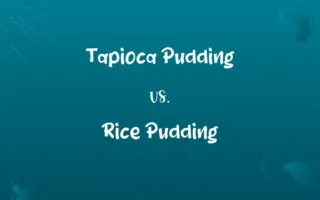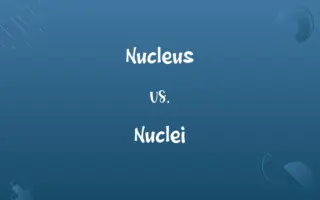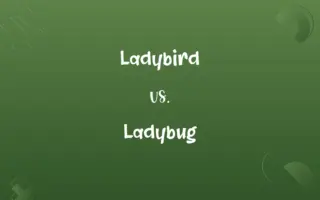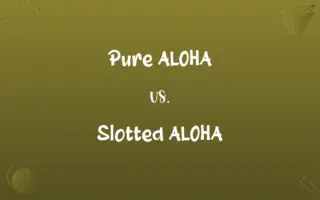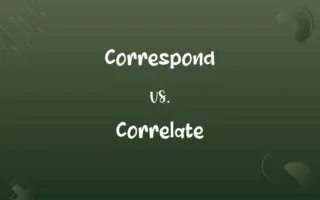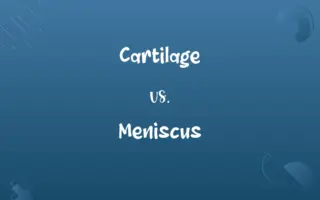Meristematic Tissue vs. Permanent Tissue: Know the Difference

By Shumaila Saeed || Published on February 9, 2024
Meristematic tissue is composed of undifferentiated, actively dividing cells in plants, while permanent tissue consists of cells that have differentiated and ceased to divide.

Key Differences
Meristematic tissue is found in regions of the plant where growth occurs, such as the tips of roots and shoots. These cells are capable of continuous division. Permanent tissue, on the other hand, is made up of cells that have completed their growth and differentiation process, forming the bulk of the plant.
Shumaila Saeed
Feb 09, 2024
Cells in meristematic tissue are smaller, with thin walls and large nuclei, adapting them for rapid division. In contrast, cells in permanent tissue have more defined and often thicker cell walls, with more specialized functions, such as conducting water or providing structural support.
Shumaila Saeed
Feb 09, 2024
The primary role of meristematic tissue is to facilitate growth and development in plants, contributing to lengthening of shoots and roots. Permanent tissues, however, serve various specialized functions, including photosynthesis, storage, and support, depending on their type (e.g., parenchyma, collenchyma, sclerenchyma).
Shumaila Saeed
Feb 09, 2024
Meristematic tissues are divided into apical meristems (at the tips of roots and shoots) and lateral meristems (facilitating growth in girth). Permanent tissues are classified based on their functions, such as dermal tissue for protection, vascular tissue for transport, and ground tissue for various functions including storage.
Shumaila Saeed
Feb 09, 2024
The transformation from meristematic to permanent tissue involves the process of cell differentiation, where cells take on specific roles. This process is crucial for the plant's development, leading to the formation of various organs and structures essential for the plant’s survival and reproduction.
Shumaila Saeed
Feb 09, 2024
ADVERTISEMENT
Comparison Chart
Function
Growth and development of the plant
Specialized functions like photosynthesis, support
Shumaila Saeed
Feb 09, 2024
Location in Plant
Tips of roots and shoots, and in cambium
Throughout the plant body
Shumaila Saeed
Feb 09, 2024
Cell Characteristics
Small, thin walls, large nuclei
Thicker walls, fully differentiated
Shumaila Saeed
Feb 09, 2024
Types
Apical, lateral, and intercalary meristems
Dermal, vascular, and ground tissues
Shumaila Saeed
Feb 09, 2024
ADVERTISEMENT
Meristematic Tissue and Permanent Tissue Definitions
Meristematic Tissue
Meristematic tissue consists of undifferentiated, actively dividing cells.
The apical meristem is a type of meristematic tissue responsible for the plant's height growth.
Shumaila Saeed
Jan 11, 2024
Permanent Tissue
These tissues do not actively divide.
The vascular tissue in plants, a type of permanent tissue, is responsible for transporting nutrients and water.
Shumaila Saeed
Jan 11, 2024
Meristematic Tissue
It is the source of all plant cells.
All specialized cells in a plant originate from the meristematic tissue.
Shumaila Saeed
Jan 11, 2024
Permanent Tissue
Permanent tissue includes various types like parenchyma, collenchyma, and sclerenchyma.
The spongy parenchyma in leaf tissue facilitates gas exchange.
Shumaila Saeed
Jan 11, 2024
Meristematic Tissue
Meristematic tissue contributes to plant growth.
The cambium, a meristematic tissue, is essential for increasing the girth of trees.
Shumaila Saeed
Jan 11, 2024
ADVERTISEMENT
Permanent Tissue
Permanent tissue comprises differentiated cells that have specific functions.
The bark of a tree is formed from permanent tissue providing protection.
Shumaila Saeed
Jan 11, 2024
Meristematic Tissue
It is found in the growing regions of plants.
Meristematic tissue in root tips facilitates root elongation.
Shumaila Saeed
Jan 11, 2024
Permanent Tissue
It forms the majority of the plant body.
Leaves, composed of permanent tissue, are crucial for photosynthesis.
Shumaila Saeed
Jan 11, 2024
Meristematic Tissue
These tissues are characterized by rapid cell division.
The rapid growth of new leaves is attributed to the activity of meristematic tissue.
Shumaila Saeed
Jan 11, 2024
Permanent Tissue
It provides structural support and storage in plants.
The storage of starch in roots is a function of certain permanent tissues.
Shumaila Saeed
Jan 11, 2024
Repeatedly Asked Queries
Do Permanent Tissues continue to divide and grow like Meristematic Tissue?
No, Permanent Tissue cells have lost the ability to divide and primarily serve specific functions.
Shumaila Saeed
Feb 09, 2024
What are the main types of Permanent Tissue?
parenchyma, collenchyma, and sclerenchyma (for support), and xylem and phloem (for transport).
Shumaila Saeed
Feb 09, 2024
What is permanent tissue?
Permanent tissue consists of differentiated cells that have specific functions and no longer divide.
Shumaila Saeed
Feb 09, 2024
What is the main function of Permanent Tissue?
It performs various specialized functions such as photosynthesis, storage, and support.
Shumaila Saeed
Feb 09, 2024
Is Permanent Tissue present in all plant organs, such as leaves, stems, and roots?
Yes, permanent tissue is present in various plant organs, each adapted to perform specific functions.
Shumaila Saeed
Feb 09, 2024
What is the main function of Meristematic Tissue?
Its primary function is to produce new cells for plant growth and development.
Shumaila Saeed
Feb 09, 2024
What is meristematic tissue?
Meristematic tissue is composed of undifferentiated cells that actively divide to contribute to plant growth.
Shumaila Saeed
Feb 09, 2024
What are the two main types of Meristematic Tissue?
The two main types are apical meristems (found at the tips) and lateral meristems (found along the sides).
Shumaila Saeed
Feb 09, 2024
Does Meristematic Tissue play a role in plant repair after damage?
Yes, it can be involved in repairing damaged plant tissues by producing new cells.
Shumaila Saeed
Feb 09, 2024
Can Permanent Tissue be found in both primary and secondary plant growth?
Yes, permanent tissue is present in both primary (elongation) and secondary (thickening) growth in plants.
Shumaila Saeed
Feb 09, 2024
Can Meristematic Tissue differentiate into specialized cell types?
Yes, as meristematic cells divide, some can differentiate into various specialized cell types.
Shumaila Saeed
Feb 09, 2024
Is Meristematic Tissue found in both woody and herbaceous plants?
Yes, it is found in both types of plants and contributes to their growth.
Shumaila Saeed
Feb 09, 2024
Do all plant cells have the potential to become part of Meristematic Tissue?
No, only specific cells in meristematic regions retain the ability to divide and contribute to growth.
Shumaila Saeed
Feb 09, 2024
Do both Meristematic and Permanent Tissues coexist in the same plant?
Yes, they coexist, with meristematic tissue responsible for generating new cells that eventually become part of the permanent tissue.
Shumaila Saeed
Feb 09, 2024
Do both Meristematic and Permanent Tissues play a role in plant adaptation?
Yes, meristematic tissue allows for growth and adaptation, while permanent tissue performs various specialized functions to support plant survival.
Shumaila Saeed
Feb 09, 2024
Are Meristematic and Permanent Tissues equally distributed in plant organs?
No, their distribution varies within plant organs, with meristematic tissue concentrated in regions of growth and permanent tissue dispersed throughout the plant.
Shumaila Saeed
Feb 09, 2024
Share this page
Link for your blog / website
HTML
Link to share via messenger
About Author
Written by
Shumaila SaeedShumaila Saeed, an expert content creator with 6 years of experience, specializes in distilling complex topics into easily digestible comparisons, shining a light on the nuances that both inform and educate readers with clarity and accuracy.




















